(code 08)
CHIANGMAI – DOI SUTHEP TEMPLE – HOME INDUSTRIES – ELEPHANT AT WORK – SAFARI – BAMBOO RAFTING – WATERFALL – CHIANGMAI – LAMPHUN – LAMPANG – SI SATCHANALAI HISTORIC PARK – SUKHOTHAI HISTORIC PARK – LOPBURI – AYUTHAYA HISTORIC PARK
DAY 1 : CHIANGMAI – DOI SUTHEP TEMPLE – HOME INDUSTRIES (OVERNIGHT)
Morning, Arrival and transfer to Your Hotel after checking in we zoom you off to 1st stop- Phu-Ping Rajnivej, Royal Winter Palace – an occasion home to the Royal Thai family ( open only weekends and Public Holidays ) Visit the Historic Doi Suthep Temple (3,500 feet above sea level) with its gardens baluster the holy pagoda containing relics of the Lord Buddha. Return from Doi Suthep
Afternoon, After Lunch we take you to the famous Thai Handicraft Village : Sankhampang – Silk & Cotton hand weaing factories you might catch a glimpse of the complete life cycle of the silk moth at the back of the factory. Borsang, umbrella and primitive paper making village. Wood Carving Silverware & Lacquerware can be found here and if you are looking for some souvenirs to bring back home this is where you can find it all.
Evening, Join our Khantoke Dinner & Hilltribe Show – additional charges or spend the night strolling and enjoying the nightlife of the city – Sorry Dinner not provided. If you have a desire for French Cuisuine and be treated like a V.I.P come wine and dine at Le Coq d’Or restaurant. There is a full range of French Wine and the food is simply “oohh lah lah”
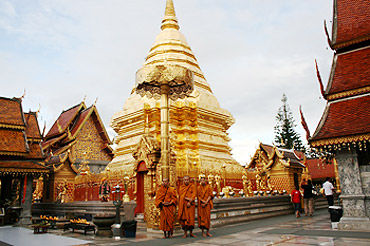
DAY 2: CHIANGMAI ELEPHANT AT WORK -SAFARI – BAMBOO RAFTING (OVERNIGHT)*
Full Day, After breakfast served in hotel we continue our tour to see the elephant at work in the Jungle and take a Ride on the Elephant’s back through the jungle for an hour. Getting off the back of the elephant we proceed with Oxen Cart Ride
Afternoon, After lunch continue exploring the beauty of the country side along Mae Taeng River by Bamboo Rafting for another hour. A stop over is made at the Orchid Farm. Visit remote primitive Meo Hill Tribes, Mae Sa Waterfall, Butterfly Farm, on the way back
Evening, Arriving back, free time leisure and shopping – Dinner not served if you have not join our Khantoke Dinner and HillTribe Show ask our guides we will sign you up for it.
If you have not tried French Cuisuine and like a V.I.P treatment come wine and dine at Le Coq d’Or restaurant. There is a full range of French Wine and the food is simply “oohh lah lah”. Phone for courtesy limousine. Spend the night in Chiangmai.
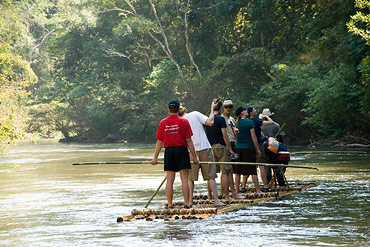
DAY 3 : CHIANGMAI -LAMPHUN – LAMPANG – SI SATCHANALAI (OVERNIGHT)*
Full Day, After breakfast in hotel, leave Chiangmai for Lamphun visit Wat Prathat Haripoonchai – a large and important temple complex founded in 897 AD located in the South town of Lamphoon the journey continues to visit Wat Prathat Lampang Luang – rated the most interesting temple in Noorthern Thailand.
Afternoon, After lunch the tour continues to Si Satchanalai Historic Park, with many beautiful and ancient temples to see and praise for the wonderful architecture namely Wat Prasirattanamahatat built in 1286AD, Wat Nang Phaya, Wat Chedi Chet Thaew- an imposing collection of chedi of different shape, size and styles. Wat Chang Lom built in 1290 AD, Wat Khao Sawan Kiri built on top of a small hill with imposing statutes of Buddha.
Evenings, Spend the night in Sukhothai Lodging provided. Sorry No Dinner Try the local roadside stalls they are much cheaper and delicious
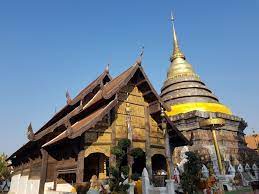
DAY 4: SUKHOTHAI HISTORIC PARK – LOPBURI HISTORIC PARK (OVERNIGHT)*
Full Day, After breakfast served in hotel the tour continues to visit Sukhothai Historic Park, Wat Mahatat built in 1240 AD is the principal shrine of the kindom still drawing thousands of pilgrims to worship. Wat Si Chum 1500 metres away houses massive seated Buddha 15 metres high and 11 metres wide. Wat Phra Phai Luang built in 1200 AD, Wat Trapang, Wat Sa Si- built on an island in a lake and Wat Si Sawai where many metal religious objects excavated.
Afternoon, After lunch depart Sukhothai and heads for Lopburi arriving in the evening.
Evening, Arriving in Lopburi. Free and leisure time. – Dinner not served- looked for you own. Try the local staffs they are cheap and you get to experience real Thai food
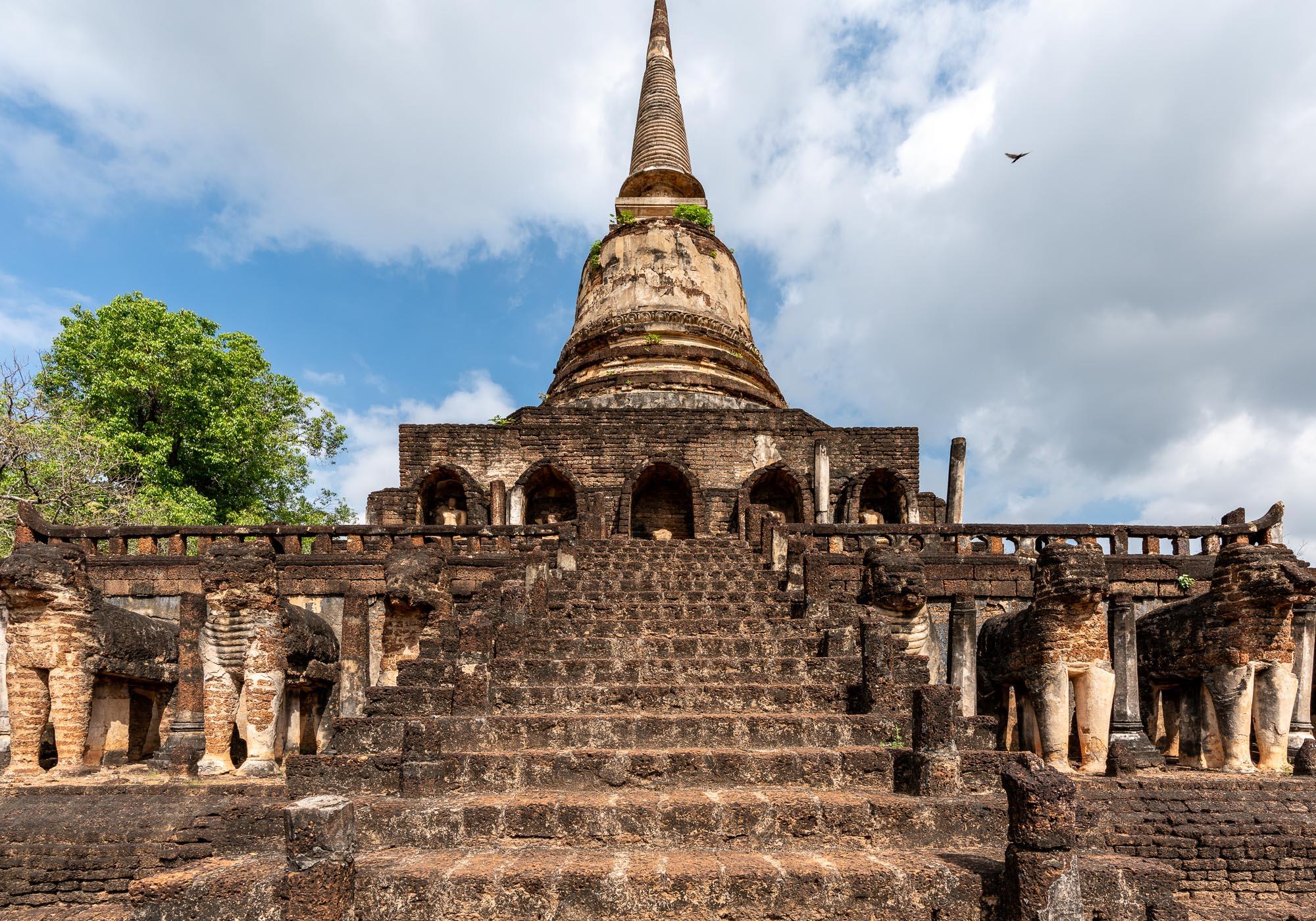
DAY 5: LOPBURI HISTORIC PARK – AYUTHAYA (OVERNIGHT)*
Morning, After breakfast served in hotel, our journey continues to Lopburi Historic Park, Wat Mahatat, King Nalai Palace. Afternoon, After lunch depart Lopburi for Ayuthaya
Evening, Arriving in Ayuthaya, free leisure time and spends the night at Krungsri River Hotel (Ayuthaya)-Dinner not served Try the local stall for cheap and tasty food
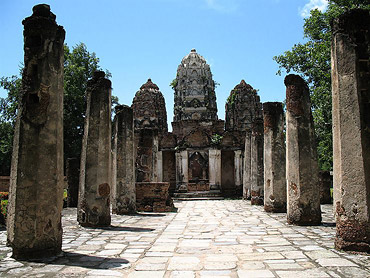
DAY 6: AYUTHAYA HISTORIC PARK -BANGKOK -YOUR COUNTRY
Morning, After breakfast served in hotel our tour continue to the Ayuthaya Historic Park, Wat Luang, Wat Prasat, Wat Prasi Mahatat. Afternoon, Leave Ayuthaya for Bangkok and from Bangkok for your country.
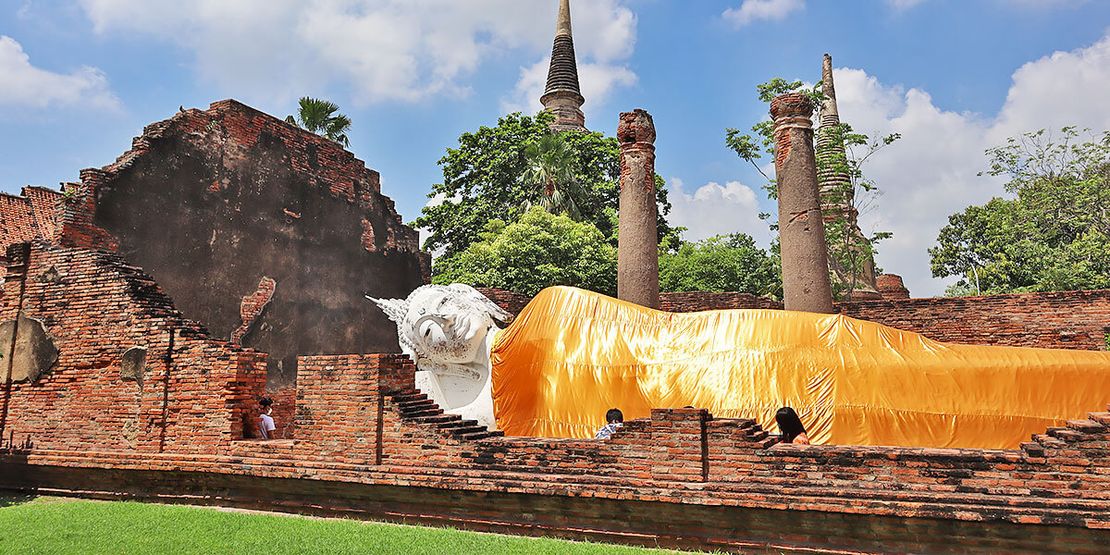
Outstanding Universal Value
Brief synthesis
The Historic City of Ayutthaya, founded in 1350, was the second capital of the Siamese Kingdom. It flourished from the 14th to the 18th centuries, during which time it grew to be one of the world’s largest and most cosmopolitan urban areas and a center of global diplomacy and commerce. Ayutthaya was strategically located on an island surrounded by three rivers connecting the city to the sea. This site was chosen because it was located above the tidal bore of the Gulf of Siam as it existed at that time, thus preventing attack of the city by the sea-going warships of other nations. The location also helped to protect the city from seasonal flooding.
The city was attacked and razed by the Burmese army in 1767 who burned the city to the ground and forced the inhabitants to abandon the city. The city was never rebuilt in the same location and remains known today as an extensive archaeological site.
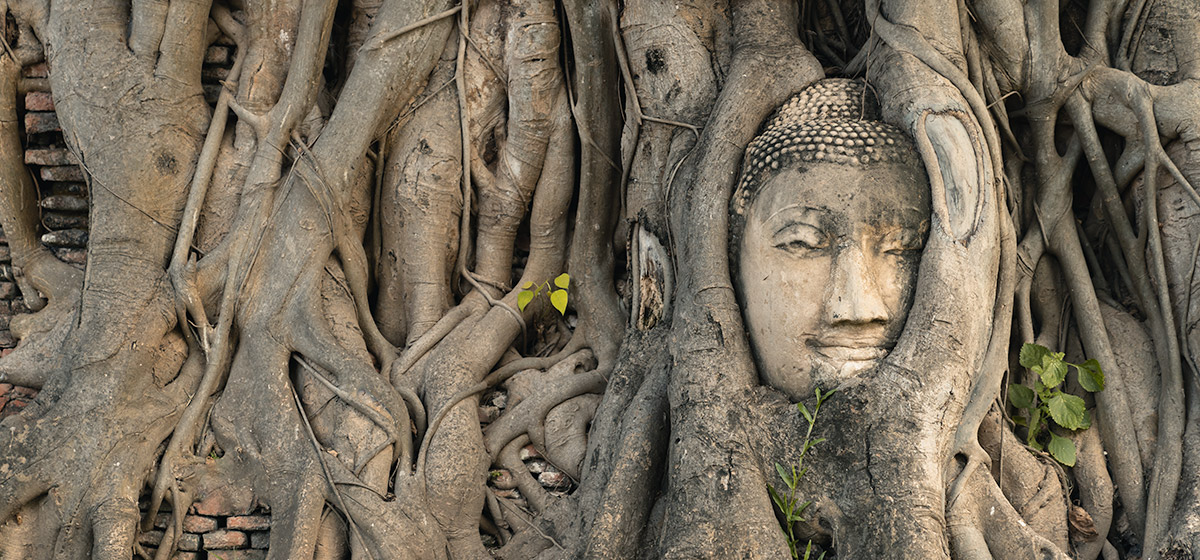
At present, it is located in Phra Nakhon Si Ayutthaya District, Phra Nakhon Si Ayutthaya Province. The total area of the World Heritage property is 289 ha.
Once an important center of global diplomacy and commerce, Ayutthaya is now an archaeological ruin, characterized by the remains of tall prang (reliquary towers) and Buddhist monasteries of monumental proportions, which give an idea of the city’s past size and the splendor of its architecture.
Well-known from contemporary sources and maps, Ayutthaya was laid out according to a systematic and rigid city planning grid, consisting of roads, canals, and moats around all the principal structures. The scheme took maximum advantage of the city’s position in the midst of three rivers and had a hydraulic system for water management which was technologically extremely advanced and unique in the world.
The city was ideally situated at the head of the Gulf of Siam, equi-distant between India and China and well upstream to be protected from Arab and European powers who were expanding their influence in the region even as Ayutthaya was itself consolidating and extending its own power to fill the vacuum left by the fall of Angkor. As a result, Ayutthaya became a center of economics and trade at the regional and global levels, and an important connecting point between the East and the West. The Royal Court of Ayutthaya exchanged ambassadors far and wide, including with the French Court at Versailles and the Mughal Court in Delhi, as well as with imperial courts of Japan and China. Foreigners served in the employ of the government and also lived in the city as private individuals. Downstream from the Ayutthaya Royal Palace there were enclaves of foreign traders and missionaries, each building in their own architectural style. Foreign influences were many in the city and can still be seen in the surviving art and in the architectural ruins.
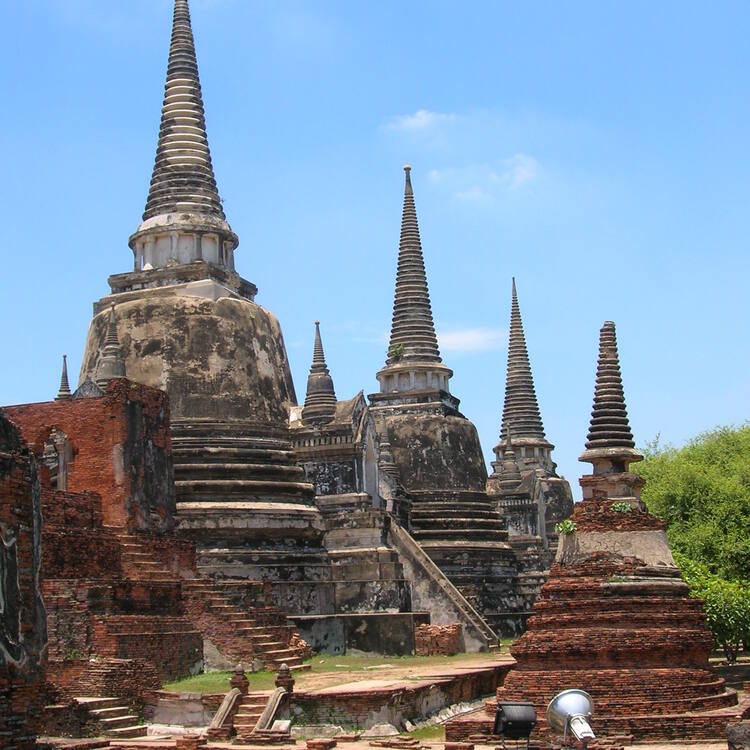
The Ayutthaya school of art showcases the ingenuity and the creativity of the Ayutthaya civilization as well as its ability to assimilate a multitude of foreign influences. The large palaces and the Buddhist monasteries constructed in the capital, for example at Wat Mahathat and Wat Phra Si Sanphet, are testimony to both the economic vitality and technological prowess of their builders, as well as to the appeal of the intellectual tradition they embodied. All buildings were elegantly decorated with the highest quality of crafts and mural paintings, which consisted of an eclectic mixture of traditional styles surviving from Sukhothai, inherited from Angkor, and borrowed from the 17th and 18th century art styles of Japan, China, India, Persia and Europe, creating a rich and unique expression of a cosmopolitan culture and laying the foundation for the fusion of styles of art and architecture popular throughout the succeeding Rattanakosin Era and onwards.
Indeed, when the capital of the restored kingdom was moved downstream and a new city built at Bangkok, there was a conscious attempt to recreate the urban template and architectural form of Ayutthaya. Many of the surviving architects and builders from Ayutthaya were brought in to work on building the new capital. This pattern of urban replication is in keeping with the urban planning concept in which cities of the world consciously try to emulate the perfection of the mythical city of Ayodhaya. In Thai, the official name for the new capital at Bangkok retains “Ayutthaya” as part of its formal title.
PACKAGE INCLUDED :
- Accommodation Twin or Double Bed
- Daily breakfast.
- Air Condition Transportation.
- Tour programs + Entrance fee as indicated in the itinerary.
- English Speaking Guide.
- Meal as indicated
- Free Travel Accident Insurance.
TERM & CONDITION:
- All above rates are nett and quoted in Thai Baht per person.
- Rate in Thai Baht inclusive Tax.
- Child : Under Age 11 years at 75% of Adult Rate
| Duration ( Half Board ) | Private Tour | Twin / Double | Single |
| 6 Days / 5 Nights minimum 2 person | Price | ||
| Hotel accommodation | Tourist class | 33,000.00 Baht | 36,000.00 Baht |
| Hotel accommodation | First class | 43,000.00 Baht | 55,000.00 Baht |





